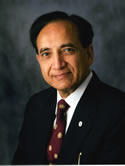Desmoid tumors of the head and neck - A clinical study of a rare entity Journal Article
| Authors: | Hoos, A.; Lewis, J. J.; Urist, M. J.; Shaha, A. R.; Hawkins, W. G.; Shah, J. P.; Brennan, M. F. |
| Article Title: | Desmoid tumors of the head and neck - A clinical study of a rare entity |
| Abstract: | Background. Desmoid tumors are are, nonmalignant neoplasms that show locally aggressive growth but lack the potential to metastasize. Common anatomic sites include the extremity, abdominal wall, and mesentery. Little is reported about clinical features and outcome of desmoid tumors of the head and neck. Methods. Twenty-one patients with desmoid tumors of the head and neck treated at MSKCC between July 1982 and June 1999 were identified from our inpatient tumor database. All patients underwent surgical resection and were prospectively followed. Clinicopathologic features and treatment modalities were evaluated. Results. Patient age at diagnosis was 22 to 76 years, with a female-male ratio of 16:5. Most tumors were located in the supraclavicular fossa or the muscles of the neck (n = 19). Patients most commonly had a painless mass (n = 13) or neurologic symptoms including pain or neurologic deficit (n = 8). Extent of resection was limited to the tumor in nine patients. In the other 12, structures including the accessory or phrenic nerve, parts of the brachial plexus, or bony structures were resected. Persistent neurologic or functional deficits after surgery were noted in 12 patients. Five of 21 patients had recurrences (24%). Eleven patients received radiation therapy. In this small population, no obvious benefit for patients receiving radiation vs patients who were not irradiated, regardless of their surgical margin status, was seen. Treatment for recurrence was re-resection or re-resection plus radiation. Eighteen patients remained free of disease after treatment, two patient have stable disease and one died of other causes. No patients died of their disease. Conclusions. Desmoid tumors of the head and neck are rare, fibrous neoplasms with a good prognosis but significant morbidity. Function-preserving surgery should be a primary goal to minimize morbidity. In this small group of patients, the benefits of radiation therapy in patients with positive margins could not be clearly demonstrated and should be balanced against radiation-related morbidity. (C) 2000 John Wiley and Sons, Inc. |
| Keywords: | adult; clinical article; human tissue; treatment outcome; aged; middle aged; cancer surgery; survival rate; clinical feature; cancer recurrence; cancer radiotherapy; prospective studies; pain; radiation; incidence; morbidity; risk factors; registries; head and neck neoplasms; age distribution; neurologic disease; head and neck; head and neck tumor; sex distribution; desmoid tumor; fibromatosis, aggressive; bone resection; brachial plexus; humans; prognosis; human; male; female; priority journal; article; desmoid; resection margins |
| Journal Title: | Head & Neck |
| Volume: | 22 |
| Issue: | 8 |
| ISSN: | 1043-3074 |
| Publisher: | John Wiley & Sons, Inc. |
| Date Published: | 2000-12-01 |
| Start Page: | 814 |
| End Page: | 821 |
| Language: | English |
| DOI: | 10.1002/1097-0347(200012)22:8<814::aid-hed11>3.0.co;2-# |
| PUBMED: | 11084643 |
| PROVIDER: | scopus |
| DOI/URL: | |
| Notes: | Export Date: 18 November 2015 -- Source: Scopus |
Altmetric
Citation Impact
BMJ Impact Analytics
Related MSK Work






